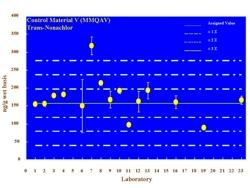NIST/NOAA Intercomparison Program for Organic and Inorganic Contaminants in Marine Mammal Tissues
Summary
The National Institute of Standards and Technology (NIST), in support of the National Oceanic and Atmospheric Administration's Marine Mammal Health and Stranding Response Program (NOAA MMHSRP), conducts interlaboratory comparison exercises for the determination of persistent organic pollutants, fatty acids, and trace elements in marine mammal tissues. The exercises provide a way for laboratories to evaluate their measurements on marine mammal tissues relative to peer laboratories. The exercise has been held about every other year since the 1991 and in recent years has attracted about 50 laboratories from the US and many other countries. Cumulative results compiled from the exercises indicate that laboratory agreement with target exercise values improves with the number of years a laboratory participates in the exercise.
Description

Results of an intercomparison exercise with data markers indicating laboratory performance.
NIST manages the quality assurance of sampling and analysis of marine mammal tissues for persistent organic pollutants and trace elements. This process includes periodically coordinating interlaboratory comparison exercises for analytes relevant to NOAA's marine mammal monitoring efforts. The exercise consists of a trace element portion and a persistent organic pollutant portion. For each exercise, laboratories are requested to analyze an unknown marine mammal tissue (typically blubber for organic contaminants and liver for trace elements) and a control material with known values for a list of target and optional analytes. No analytical methods are prescribed, rather exercise participants apply in-house measurement techniques to establish data that are compared to benchmark values. NIST advertises the exercises, distributes the materials, participates in the exercises, performs a comprehensive statistical analysis, and compiles information into a summary report that is distributed to the participants. There is no fee to participate in these exercises. The last formal exercises were held in 2007. During the period from 1991 to 2007, the program served to lower among laboratory data uncertainty for participants with continuing participation. The quality assurance exercise component of the MMHSRP is currently under review by NOAA and may be modified from its present form to include new target analytes and/or tissue types.
SUMMARY OF THE 2007 EXERCISES
Organic Exercise: 21 data sets were submitted by 14 laboratories on requested organohalogen compounds in marine mammal blubber and serum or fatty acids in marine mammal blubber. The materials distributed for the 2007 exercise included SRM 1945 Organics in Whale Blubber, SRM 1958 Human Serum (Fortified), a homogenized blubber control material "Marine Mammal Quality Assurance Exercise Homogenate VIII" (Homogenate VIII) from a Female pilot whale and "Marine Mammal Control Material 1-Serum" (MMCM1-serum) derived from an adult male California sea lion (Zalophus californianus).
Trace Element Exercise: 20 Laboratories participated to measure Ag, As, Cd, Co, Cs, Cu, Fe, Hg, Mn, Mo, Ni, Rb, Sb, Se, Sn, V, and Zn in an unknown whole blood sample (QC06WLB1) derived from California Sea Lion (Z. californianus). Control materials SRM 1598a Inorganic Constituents in Animal Serum and QC03LH3 Pygmy Sperm Whale Liver Homogenate were distributed to benchmark the analytical procedures. Robust statistical approaches utilized in International Key Comparision exercises were applied to derive consensus data estimates of concentration and dispersion.
PUBLICATIONS
- Christopher, S.J., R.S. Pugh, M.B. Ellisor, E.A. Mackey, R.O. Spatz, B.J. Porter, K.J. Bealer, J.R. Kucklick, T.K. Rowles, and P.R. Becker, Description and results of the NIST/NOAA 2005 interlaboratory comparison exercise for trace elements in marine mammals. Accreditation and Quality Assurance, 2007. 12:175-187.
- Kucklick, J.R., M.M. Schantz, R.S. Pugh, B.J. Porter, D.L. Poster, P.R. Becker, T.K. Rowles, S. Leigh, and S.A. Wise, Marine Mammal Blubber Reference and Control Materials for Use in the Determination of Halogenated Organic Compounds and Fatty Acids. Analytical and Bioanalytical Chemistry, 2010. 397:423-432.
- NISTIR 7269 Description and Results of the 2003 NIST/NOAA Interlaboratory Comparison Exercise Program for Organic Contaminants in Marine Mammal Tissues.
- NISTIR 7410 Description and Results of the 2005 NIST/NOAA Interlaboratory Comparison Exercise Program for Organic Contaminants in Marine Mammal Tissues.
- NISTIR 7642 Description and Results of the 2007 NIST/NOAA Interlaboratory Comparison Exercise Program for Organic Contaminants in Marine Mammal Tissues.
- NISTIR 7361 Results and Description of the NIST/NOAA 2005 Interlaboratory Comparison Exercise for Trace Elements in Marine Mammals.
- NISTIR 7528 Results and Description of the NIST/NOAA 2007 Interlaboratory Comparison Exercise for Trace Elements in Marine Mammals.

